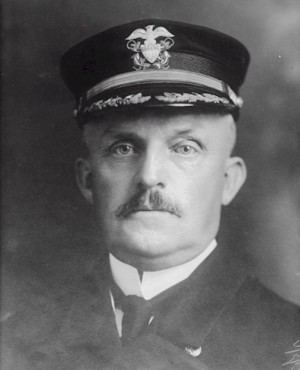Years of service 1877–1921 | Rank Admiral Name Albert Gleaves | |
 | ||
Born January 1, 1858Nashville, Tennessee ( 1858-01-01 ) Allegiance United States of America Battles/wars Spanish–American WarWorld War I Awards Distinguished Service Medal Books The Admiral: The Memoirs of Albert Gleaves, Admiral, USN Battles and wars | ||
Albert Gleaves
Albert Gleaves (January 1, 1858 – January 6, 1937) was a decorated admiral in the United States Navy, also notable as a naval historian.
Contents

Biography
Born in Nashville, Tennessee, Gleaves graduated from the United States Naval Academy in 1877. After serving on board Hartford and Trenton, he was appointed an Ensign in 1881. Assigned to many ships and stations, he commanded Cushing during the Spanish–American War and later the battleship North Dakota. Promoted to rear admiral in 1915, in World War I he commanded the Cruiser and Transport Force. For his outstanding contribution he was awarded the Army and Navy Distinguished Service Medals.
In 1919 he was promoted to Admiral and commanded the Asiatic Fleet. While serving at the Naval Ordnance Proving Ground, Admiral Gleaves made outstanding contributions in the field of gunnery and torpedoes. While carrying out some tests on torpedo steering devices he changed these weapons from instruments of luck into instruments of precision. The gear which he tested in Cushing provided the imprints which made the torpedo the "terrible weapon" of World War I.
In spite of a life of constant action in war and peace, he found time to write a biography of Captain James Lawrence; the History of the Cruiser and Transport Force, and the Life of an American Sailor, William Hensley Emory, Rear Admiral, USN. After a most distinguished career, he retired in January 1, 1922.
He was a companion of the Naval Order of the United States and was assigned insignia number 756.
Admiral Gleaves died at Haverford, Pennsylvania, January 6, 1937, a few days after his 79th birthday.
He has been quoted as saying, "To seamen a ship becomes endowed with human virtues and faults; she ceases to be a mere inanimate thing."
Decorations
Here is Admiral Albert Gleaves's ribbon bar:
Namesake
USS Gleaves (DD-423), a Gleaves-class destroyer, was the lead ship of her class and named for Admiral Gleaves.
